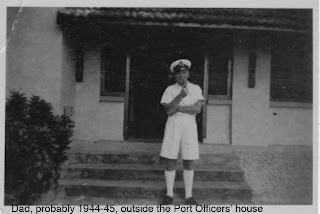Mum and Dad met in Dar-es-Salaam in 1944.
Mum had been born in Kenya, gone to Scotland to get her higher education and took nurses training at the Western Infirmary, Glasgow. When she returned to Africa after WW II, she was nursing in Dar-es-Salaam.
Dad had been in the British Merchant Navy that he apprenticed into at age 15. By the time WW II ended, he was a Master Mariner (Captain), but he decided to leave the Merchant Navy. He got a job as a pilot in the Dar-es-Salaam harbour.
The nurses residence was close to the Port Officers residence (called the Pilot House, I think), so the single nurses and the single port officers spent off-times together. I guess more than one romance bloomed.
Many of these pictures are in an album that is falling apart. Fortunately, most of them were still stuck to the pages, and in most cases, I could figure out which photos went where if they had fallen out. Sometimes from the notes Mum wrote, and sometimes from memory because I remember going through the old albums many times growing up. I loved to listen to the stories Mum told about her childhood and days in Africa with Dad.
In some of these pictures, you will notice a yellow stain in the centre of the photo. This is from the glue on the little folded paper mount holding it onto the page. It's funny, but not all of them show a stain, so it must be different types of glue.
Mum told me lots of stories about sailing the Vixen, a small sailboat. I'm not sure who it belonged to, but apparently Mum & Dad's circle of friends spent a lot of time on it, and on the beaches around about.
I guess Dad was called Robbie there. I never knew him to be called anything other than Jim.
Mum looks so young here! She would have been about 24.
Doesn't he look debonnaire!
Engagement
There were only these two photos labeled engagement. Now, onto the wedding photos!
Wedding Nairobi, Kenya, 11 August, 1945
Maid of Honour is labeled Issie. I think this is Isabella, Mum's cousin (parents are Uncle George Silver, and Aunt Agnes Silver (née McKinnon).
Then it is Mum's mum, Catherine (Katie) Johansen, Dad, Mum, Dick Halstead as Best Man, and Uncle Olaf Johansen, Mum's eldest half-brother who gave her away, I think. Uncle Olaf was just a bit younger than Grandmother when she married Granddad, and Olaf's children were like brothers and sisters to Mum. Big extended family!
Love the little smiles on their faces. But I'm sure Dad was ready for this part to be over! He was not one for a lot of fuss.
This is one of my favourites. There is just something about the dreamy look on Mum's face.
Honeymoon
Uncle Karl crashed the honeymoon. Uncle Karl was Mum's brother who I knew the best because he came to Canada, lived in Ottawa, so we saw a lot of him. He and Mum were close, and Dad really like him too. He was hard working, but when he had fun, everyone had fun - he had a wicked sense of humour, and loved to play practical jokes. But his practical jokes were never hurtful, they were always loads of fun. And he was the best story teller I ever met! I might add some more to this post, because I know Mum wrote about the honeymoon in the family history. I'll add when I find it.































